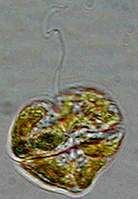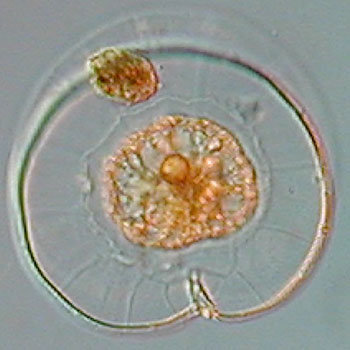Microscopic Miracles, a series of tales about small wonders of nature.

Prorocentrum
Chapter 2 - Dinoflagellates
by Cheryl Gilpin, USA.
Text and images © of the author.

Karenia
|
Microscopic Miracles, a series of tales about small wonders of nature. |
||
 Prorocentrum |
Chapter 2 - Dinoflagellates by Cheryl Gilpin, USA. Text and images © of the author. |
 Karenia |
Dear Humans,
We dinoflagellates have existed on planet Earth for millions of years. As phytoplankton (single-celled plant-like plankton), we wander within Earth's waters producing food and oxygen for the planet. Our internal skeletal plates called theca are thick dense forms of cellulose which cause us to sink removing carbon from the atmosphere for a long time and transporting the dormant cysts we from inside to the sediments where they can remain dormant for many years. Thus we play a vital role in sustaining human life on Earth by adding oxygen gas and removing carbon dioxide gas from the atmosphere.
Even though most people have never been aware of us, other people have discovered many interesting things by observing our kind. Next to diatoms, we have the highest diversity of species of the other groups of phytoplankton. We are distinguished from one another by the specific patterns on our theca, the arrangement of the thecal plates and the wrinkled patterns formed by the softer outer layer of cellulose on the outiside of our membranes. Rings, spines and sails extend from the theca of some species. Buckminster Fuller, a futuristic architect was inspired by our geometries to construct geodesic buildings. Many dinoflagellate species can play roles as both producers (converting sunlight into food) and consumers (feeding by phagotropy, like amoebas). Many of our species are bioluminescent and provide light during the night along the wake of ships, divers and dolphins. Our ocean environment once provided many fairly separate, fairly stable homes where our many different species existed in harmony and balance with the other life forms sharing our homes. But not anymore. The ocean has become scrambled like scrambled eggs.
The ocean is being scrambled by more huge hurricanes and tsunamis. Recently, something different has begun to scramble our oceans on a much larger scale than ever before - shipping, especially from ballast water exchange between ports. More shipping has also increased dredging of bays. Also, our ocean is injected with freshwater containing chemical pollutants and nutrients in more frequent and extreme flood events. The ocean is sometimes cut off from freshwater inflows by extreme drought and by over-utilization of groundwater, causing springs to sometimes flow saline and then quit flowing altogether. Now when fresh waters suddenly pulse into the ocean, the pollutants and nutrients are even more concentrated. If drought conditions exist before such a pulse the marine saline boundaries where we hang out are shifted far inland bringing more species of pelagic (open ocean ) dinoflagellates into coastal waters where we may bloom and sometimes become toxic when we get pulses of pollutants from coastal inflows.
Humans have compounded the problem of pulsing the ocean with concentrated nutrients and pollutants by fertilizing crops with marine-derived nutrients and by putting huge numbers of livestock into small feedlots and fattening them up with liquid feed made out of marine fish by-products. Were there not enough land based nutrients already? Also humans are changing ocean mixing patterns by dumping into the sea very saline brine from the process of desalination. There have been many changes recently in how humans impact the earth. No matter how far inland these human activities occur or how deep underground they are all connected to our ocean homes. Green spaces along waterways and wetlands and mangrove swamps filter many of these pollutants before they can reach the sea but many of these have been destroyed. We have provided many environmental services that support Earth as a home for humans. So why don’t humans give us a break?!!!
Some humans may think “who are the Dinoflagellates to ask us to give them a break!” It seems some humans are upset because occasionally a few of our species become a nuisance, bloom and produce toxins. But they can’t help it. No one knows why or when this is likely to happen. However, as human impacts increasingly stress the environment, toxic dinoflagellate bloom events also increase.
It is really hard to figure out what is going on while our ocean home is being scrambled and while many of our species are transported far away from their usual homes to places where they are invasive species.
We just want you humans to know that we Dinoflagellates are also upset and very sorry about these harmful algae blooms (HABs) caused by a few of our species, especially the HABs that make marine mammals sick and sometimes die. We are not doing this on purpose. We would rather exist in balance with life on Earth. We would like to work together with humans to help you make changes that might improve all of our lives on this planet.
Sincerely,
The Dinoflagellates
Comments to the author Cheryl Gilpin are welcomed.
Visit the Micscape Library for other articles in the author's 'Microscopic Miracles' series.
Background
Information and Images





Ceratium
trichoceros

A
long chain dinoflagellate.


Left,
long chain species detail; right, a cyst out of dinoflagellate theca.


Left,
Dinophysis; right, Ornithoceros.


Left,
Protoperidinium; right, Pyrophacus.
Microscopy UK Front Page
Micscape Magazine
Article
Library
Published in the May 2008 edition of Micscape.
Please report any Web problems or offer general comments to the Micscape Editor .
Micscape is the on-line monthly magazine of the Microscopy UK web site at Microscopy-UK
©
Onview.net Ltd, Microscopy-UK, and all contributors 1995
onwards. All rights reserved.
Main site is at
www.microscopy-uk.org.uk
with
full mirror at
www.microscopy-uk.net
.